Trends, Collaborations and Perspectives in the Study of Organizational Climate and Job Satisfaction: A Bibliometric and Scientometric Analysis
Abstract
1. Introduction
2. Theoretical Framework
2.1. Organizational Climate
2.2. Job Satisfaction
2.3. Relationship Between OC and JS
3. Materials and Methods
4. Results
5. Discussion
6. Conclusions
Author Contributions
Funding
Institutional Review Board Statement
Informed Consent Statement
Data Availability Statement
Conflicts of Interest
Abbreviations
| % of Tt | Percentage of articles over the total number of articles considering search vectors |
| % Tt | Percentage of total number of items |
| % Tt | Percentage of articles over the total number of articles in search vectors |
| H-A | Author’s h-index |
| H-OC | h-index with only the search vectors |
| YES Y5 | Impact factor of the journal in the last 5 years |
| JS | Job satisfactions |
| NP | Total number of articles considering only search vectors |
| OC | Organizational climate |
| PC-OC | Average citations per article |
| Q | Quartile in the category. |
| R | Classification |
| S116 | Total number of articles by the author that are among the 116 most influential articles published of all time. |
| TC | Total Citations |
| TC-A | Total number of citations per author |
| TC-CO | Total number of citations by author of articles in the search vector |
| TC-OC | Total citations of the author’s articles in the search vectors; |
| TP-A | Total number of articles by author |
| TP-CO | Total number of articles by the author in the search vector |
| TP-OC | Total number of articles by author considering search vectors |
References
- Alwali, J., & Alwali, W. (2022). The relationship between emotional intelligence, transformational leadership, and performance: A test of the mediating role of job satisfaction. Journal of Leadership and Organizational Development, 43(6), 928–952. [Google Scholar] [CrossRef]
- Anderson, N. R., & West, M. A. (1998). Measuring the climate for innovation in working groups: Development and validation of the team’s climate inventory. Journal of Organizational Behavior, 19(3), 235–258. [Google Scholar] [CrossRef]
- Andersson, M., Moen, O., & Brett, P. O. (2020). The organizational climate for psychological safety: Associations with the innovation capacities and innovation performance of SMEs. Journal of Engineering and Technology Management, 55, 101554. [Google Scholar] [CrossRef]
- Araya-Castillo, L., Hernández-Perlines, F., Moraga, H., & Ariza-Montes, A. (2021). Scientometric analysis of research on socio-emotional wealth. Sustainability, 13, 3742. [Google Scholar] [CrossRef]
- Bolos, N., & Zelazny, L. (2022). Measuring general job satisfaction: Which is more valid for the construct: Global scales or scales composed of facets? Journal of Business and Psychology, 37(1), 91–105. [Google Scholar] [CrossRef]
- Bornmann, L., & Hans-Dieter, D. (2007). What do we know about the h-index? Journal of the American Society for Information Science and Technology, 58(9), 1381–1385. [Google Scholar] [CrossRef]
- Campo-Ternera, L., Olivero Vega, E., & Huguett Herazo, S. (2018). Entrepreneurship and innovation as a driver of sustainable development: Bibliometric study (2006–2016). Journal of Social Sciences, XXIV(4), 26–37. [Google Scholar] [CrossRef]
- Contreras, F., Aldeanueva, I., Espinosa, J. C., & Abid, G. (2021). Potential and realized absorptive capacity in colombian firms: The mediating role of the organizational climate for innovation. SAGE Open, 11(4), 215824402110525. [Google Scholar] [CrossRef]
- Dada, O. (2018). A model of entrepreneurial autonomy in franchised outlets: A systematic review of the empirical evidence. International Journal of Management Reviews, 20(2), 206–226. [Google Scholar] [CrossRef]
- D’Amato, A. (2023). From research to action and back: The long journey of organizational climate: A literature review and a summative framework. Journal of General Administration, 50(4), 030630702311520. [Google Scholar] [CrossRef]
- Denison, D. R. (1996). What is the difference between organizational culture and organizational climate? A native’s point of view on a decade of paradigm wars. The Management Review Academy, 21(3), 619. [Google Scholar] [CrossRef]
- Edmondson, A. C., & Bransby, D. P. (2023). Psychological safety comes of age: Themes observed in an established literature. Annual Review of Organizational Psychology and Organizational Behavior, 10(1), 55–78. [Google Scholar] [CrossRef]
- Eliyana, A., Ma’arif, S., & Muzakki. (2019). Job satisfaction and organizational engagement: Effect on transformational leadership towards employee performance. European Research on Management and Business Economics, 25(3), 144–150. [Google Scholar] [CrossRef]
- Expósito-López, J., & Olmedo-Moreno, E. M. (2020). Scientometric analysis of publications on guidance, tutoring and tutorial action registered in databases. Formación Universitaria, 13(3), 123–138. [Google Scholar] [CrossRef]
- Federico, O. S., Díaz, F. J., & Garcés, M. E. C. (2023). Climate and job satisfaction as predictors of happiness at work in a sample of Mexican health sector officials. Accounting and Administration, 69(4), 231–253. [Google Scholar] [CrossRef]
- Glänzel, W. (2012). Bibliometric methods to detect and analyze emerging research topics. The Information Professional, 21(2), 194–201. [Google Scholar] [CrossRef]
- Granda-Orive, J., Alonso, A., García, F., Solano, S., Jimenez, C., & Aleixandre, R. (2013). Ciertas ventajas de Scopus sobre Web of Science en un análisis bibliome, trico sobre tabaquismo. Revista Española de Documentación Científica, 36, 1–9. [Google Scholar] [CrossRef]
- Hernández-Perlines, F., Araya-Castillo, L., Millán-Toledo, C., & Cisneros, M. A. I. (2023). Socio-emotional wealth: A systematic review of the literature from the perspective of a family business. European Research on Management and Business Economics, 29(2), 100218. [Google Scholar] [CrossRef]
- Hoegl, M., & Gemuenden, H. G. (2001). Quality of teamwork and success of innovative projects: A theoretical concept and empirical evidence. Science of Organization, 12(4), 435–449. [Google Scholar] [CrossRef]
- Kauppi, K., Salmi, A., & You, W. (2018). Sourcing from Africa: A systematic review and a research agenda. International Journal of Management Reviews, 20(2), 627–650. [Google Scholar] [CrossRef]
- Keupp, M. M., Palmie, M., & Gassmann, O. (2012). The strategic management of innovation: A systematic review and paths for future research. International Journal of Management Reviews, 14(4), 367–390. [Google Scholar] [CrossRef]
- Lee, M., & Kim, B. (2023). Effect of employees’ mental strength on organizational engagement and job satisfaction: Mediating psychological well-being. Administrative Sciences, 13(5), 133. [Google Scholar] [CrossRef]
- Li, Y., Huang, H., & Chen, Y.-Y. (2020). Organizational climate, job satisfaction, and turnover in child welfare volunteer workers. Children and Youth Services Review, 119, 105640. [Google Scholar] [CrossRef]
- Lintanga, A. J. b. J., & Rathakrishnan, B. (2024). The impact of the psychosocial safety climate on job satisfaction in the public sector: The moderating role of the organizational climate. BMC Psychology, 12(1), 38. [Google Scholar] [CrossRef]
- Liu, Y., Aungsuroch, Y., & Yunibhand, J. (2016). Job satisfaction in nursing: A study of concept analysis. International Journal of Nursing, 63(1), 84–91. [Google Scholar] [CrossRef]
- Malhotra, N. K. (2004). Market research: An applied approach (4th ed.). Pearson Education. [Google Scholar]
- Meneghini, R., & Packer, A. (2010). The scope of multidisciplinary authorship of articles on scientometrics and bibliometrics in Brazil. Interciencia, 35(7), 510–514. [Google Scholar]
- Mingers, J., & Leydesdorff, L. (2015). A review of theory and practice in scientometrics. European Journal of Operations Research, 246(1), 1–19. [Google Scholar] [CrossRef]
- Mozgovoy, V. (2021). Effect of the psychological climate on stress among public servants. Proceedings of the Academy of Management, 2021(1), 16026. [Google Scholar] [CrossRef]
- Mujajati, E., Ferreira, N., & du Plessis, M. (2024). Fostering organizational engagement: A resilience framework for private sector organizations in South Africa. Frontiers in Psychology, 15, 1303866. [Google Scholar] [CrossRef]
- Nalimov, V., & Mulchenko, Z. (1971). Information model of the process of development of science (Vol. 1). Division of Foreign Technology. [Google Scholar]
- Patterson, M. G., West, M. A., Shackleton, V. J., Dawson, J. F., Lawthom, R., Maitlis, S., Robinson, D. L., & Wallace, A. M. (2005). Validation of the organizational climate measure: Links with management practices, productivity and innovation. Journal of Organizational Behavior, 26(4), 379–408. [Google Scholar] [CrossRef]
- Rožman, M., & Štrukelj, T. (2021). Components of the organizational climate and their impact on employee engagement in medium-sized organizations. Economic Research-Ekonomska Istraživanja, 34(1), 775–806. [Google Scholar] [CrossRef]
- Rubiales-Núñez, J., Rubio, A., Araya-Castillo, L., & Moraga-Flores, H. (2024). Evolution of ambiguity tolerance research a scientometric and bibliometric analysis. Frontiers in Psychology, 15. [Google Scholar] [CrossRef]
- Santana, S., & Pérez-Rico, C. (2023). Dynamics of organizational climate and job satisfaction in health services practice and research: A protocol for a systematic review. Frontiers in Psychology, 14, 1186567. [Google Scholar] [CrossRef]
- Schneider, B., & Snyder, R. A. (1975). Some relationships between job satisfaction and organizational climate. Journal of Applied Psychology, 60(3), 318–328. [Google Scholar] [CrossRef]
- Shang, G., Saladin, B., Fry, T., & Donohue, J. (2015). Twenty-six years of research in operations management (1985–2010): Authorship patterns and research components in eleven top-notch journals. International Journal of Production Research, 53(20), 6161–6197. [Google Scholar] [CrossRef]
- Stamolampros, P., Korfiatis, N., Chalvatzis, K., & Buhalis, D. (2019). Determinants of job satisfaction and employee turnover in high-touch services: Information from employees’ online reviews. Tourism Management, 75, 130–147. [Google Scholar] [CrossRef]
- Tan, M. P. C., Kwan, S. S. M., Yahaya, A., Maakip, I., & Voo, P. (2020). The importance of the organizational climate for psychosocial security in the prevention of sexual harassment at work. Journal of Occupational Health, 62(1), e12192. [Google Scholar] [CrossRef]
- Toro Jaramillo, I. D. (2017). Bibliometrics and publications in theology. Theological Questions, 44(102), 229–239. [Google Scholar] [CrossRef]
- Vega-Muñoz, A., Arjona-Fuentes, J. M., Ariza-Montes, A., Han, H., & Law, R. (2020). In search of ‘a research front’ in cruise tourism studies. International Journal of Hospitality Management, 85, 102353. [Google Scholar] [CrossRef]
- Velt, H., Torkkeli, L., & Laine, I. (2020). Entrepreneurial ecosystem research: Bibliometric mapping of the domain. Journal of Business Ecosystems, 1(2), 43–83. [Google Scholar] [CrossRef]
- Viđak, M., Tomić, V., Buljan, I., Tokalić, R., & Marušić, A. (2023). Perception of the organizational climate by university staff and students of medicine and humanities: A qualitative study. Responsibility in Research, 31(7), 847–873. [Google Scholar] [CrossRef]
- Wang, X., Xu, Z., & Tijeras, M. (2020). A bibliometric analysis of economic research (2007–2019). Economic Research, 33(1), 865–886. [Google Scholar] [CrossRef]
- Xia, W., Fan, Y., Bai, J., Zhang, Q., & Wen, Y. (2024). The relationship between organizational climate and kindergarten teachers’ job satisfaction: A chain mediation model of occupational stress and emotional labor. Frontiers in Psychology, 15, 1373892. [Google Scholar] [CrossRef] [PubMed]
- Zhang, L., & Wang, Y. (2021). Impact of the consent of the organizational culture of creative talents on job satisfaction. South African Journal of Business Management, 52(1), a2214. [Google Scholar] [CrossRef]
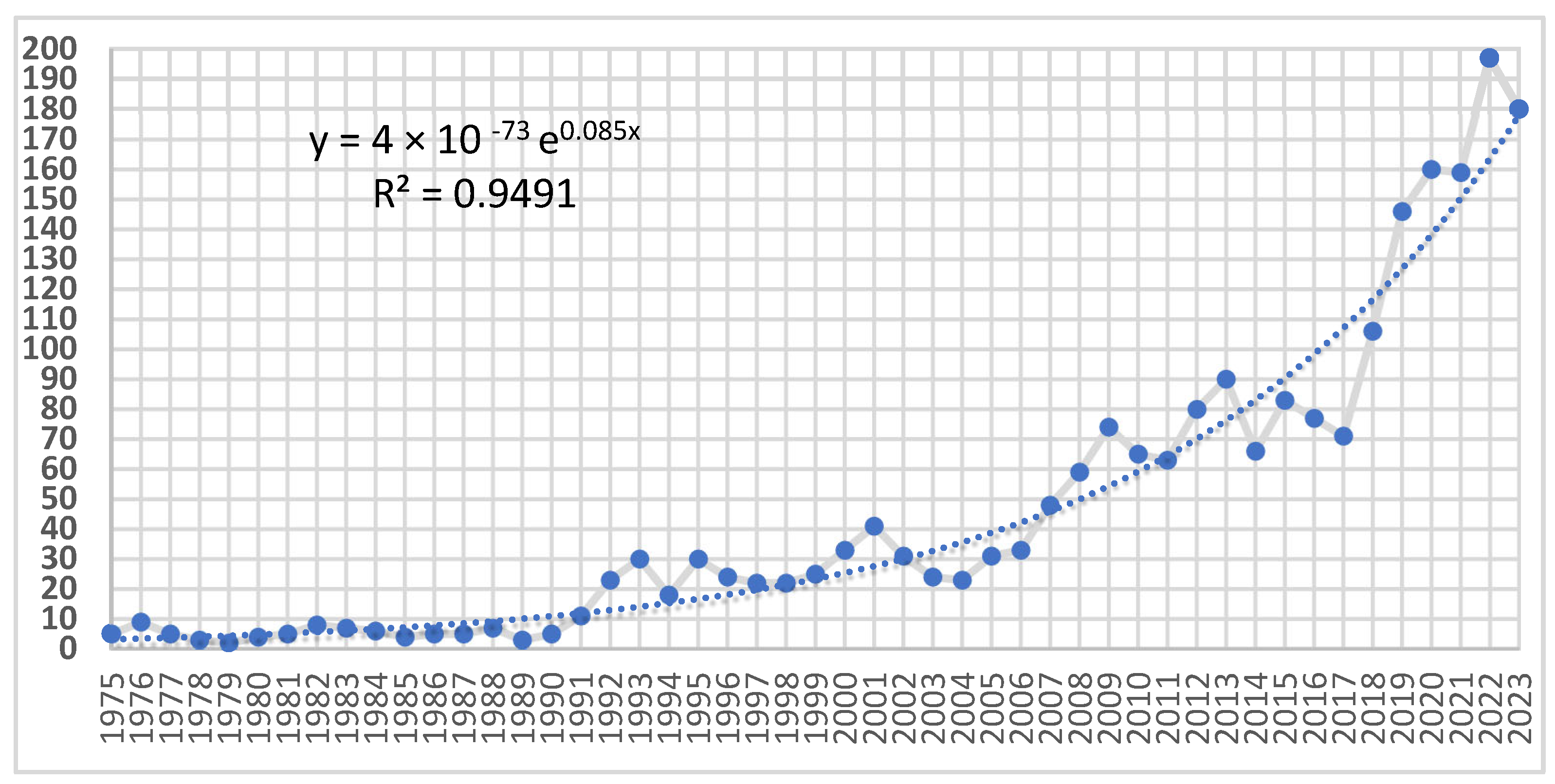
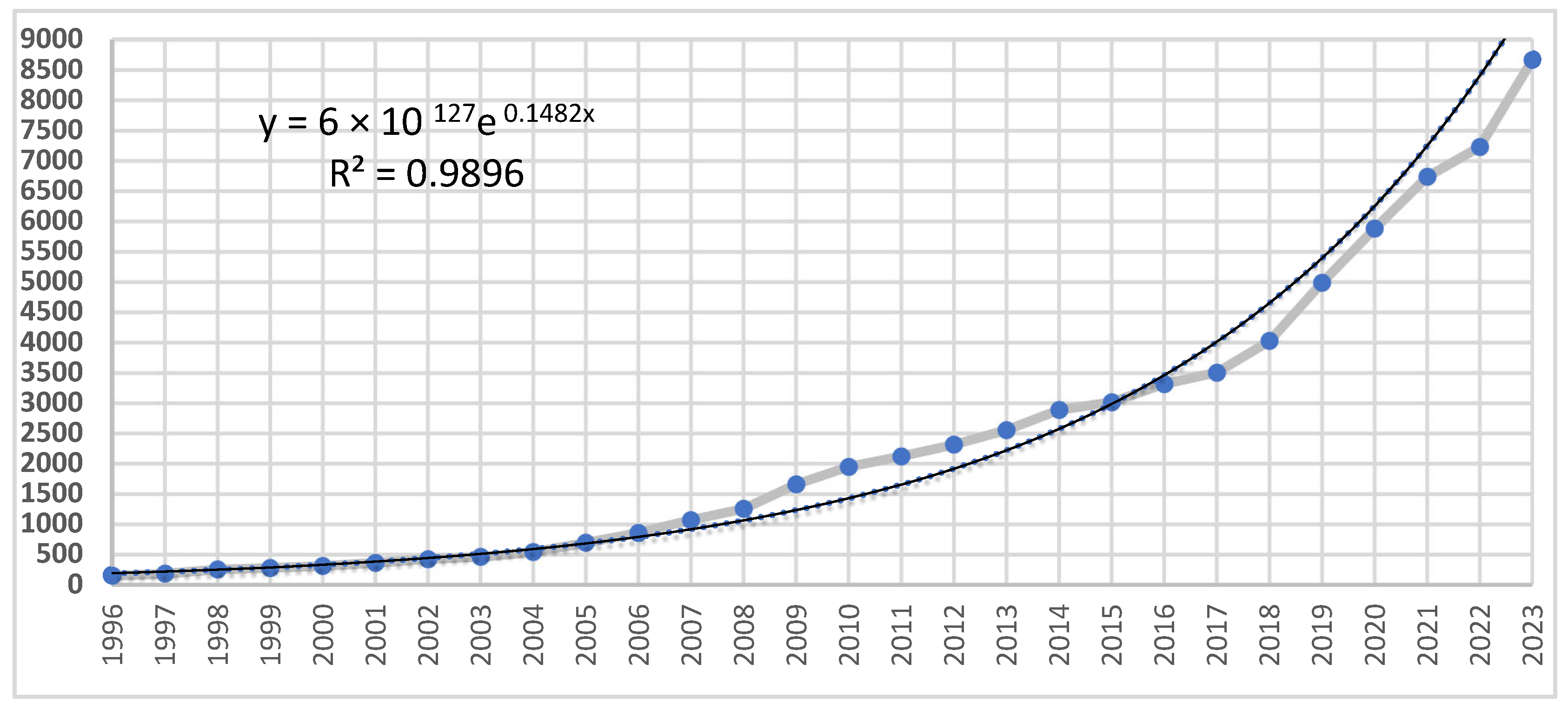
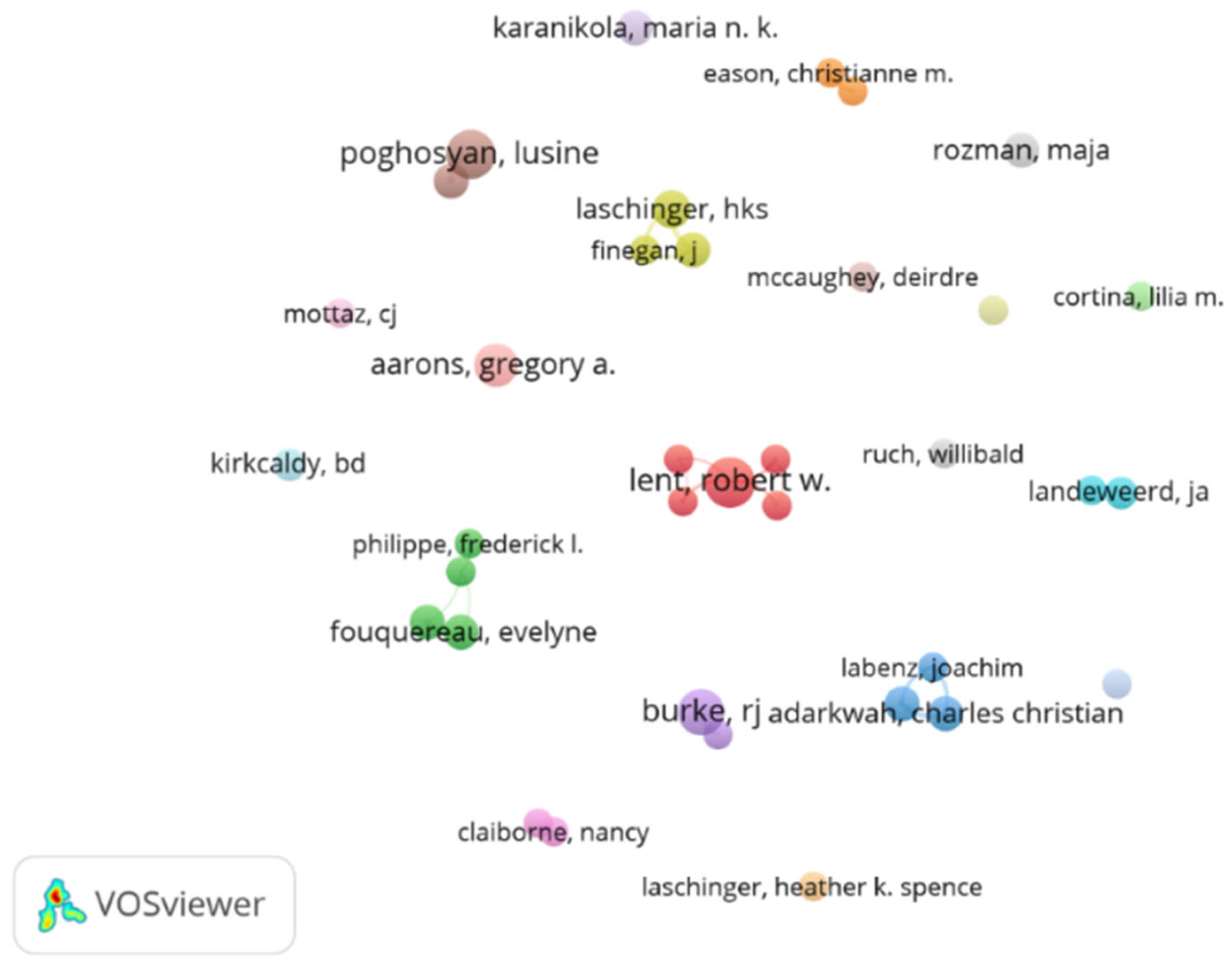
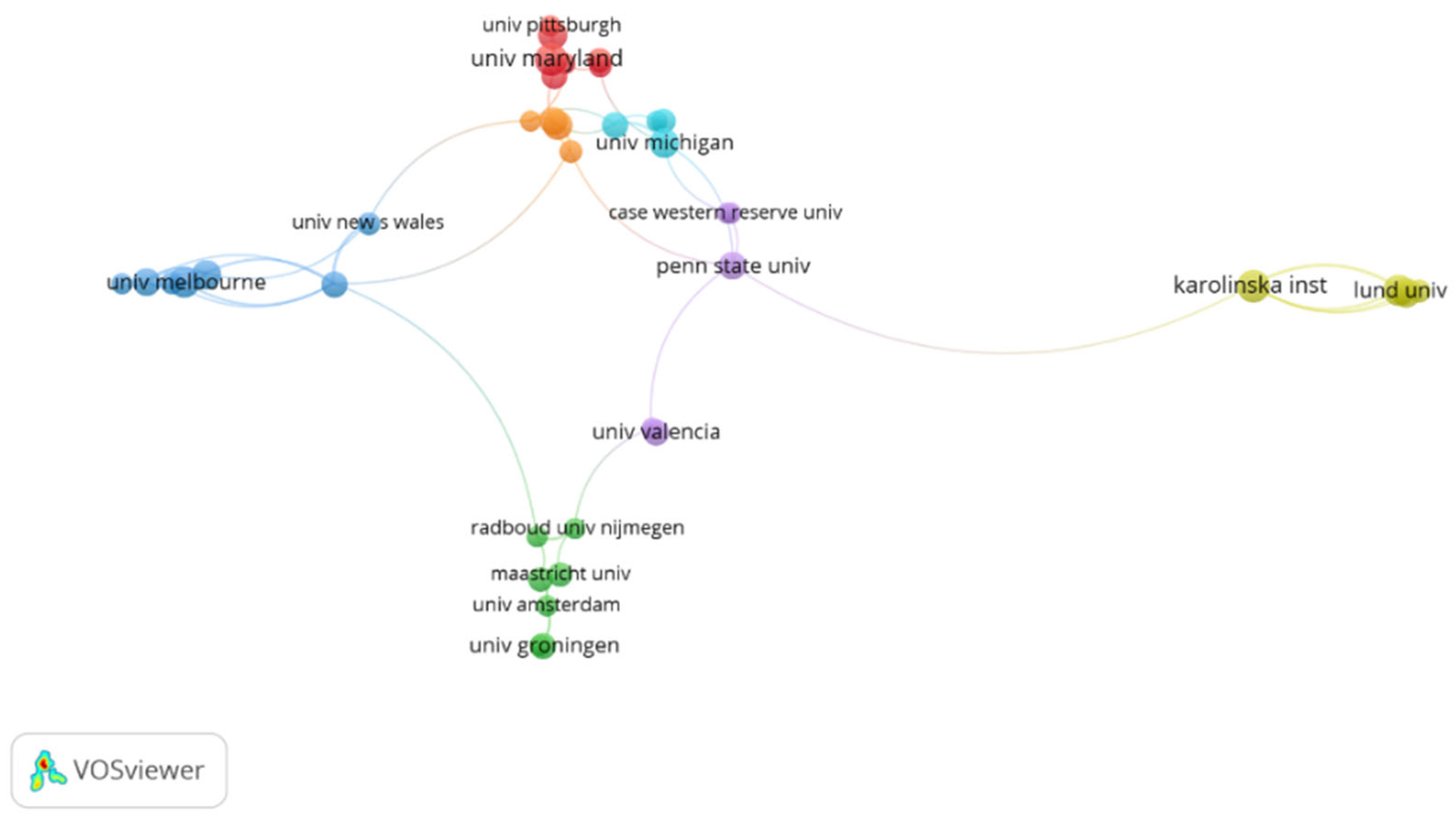
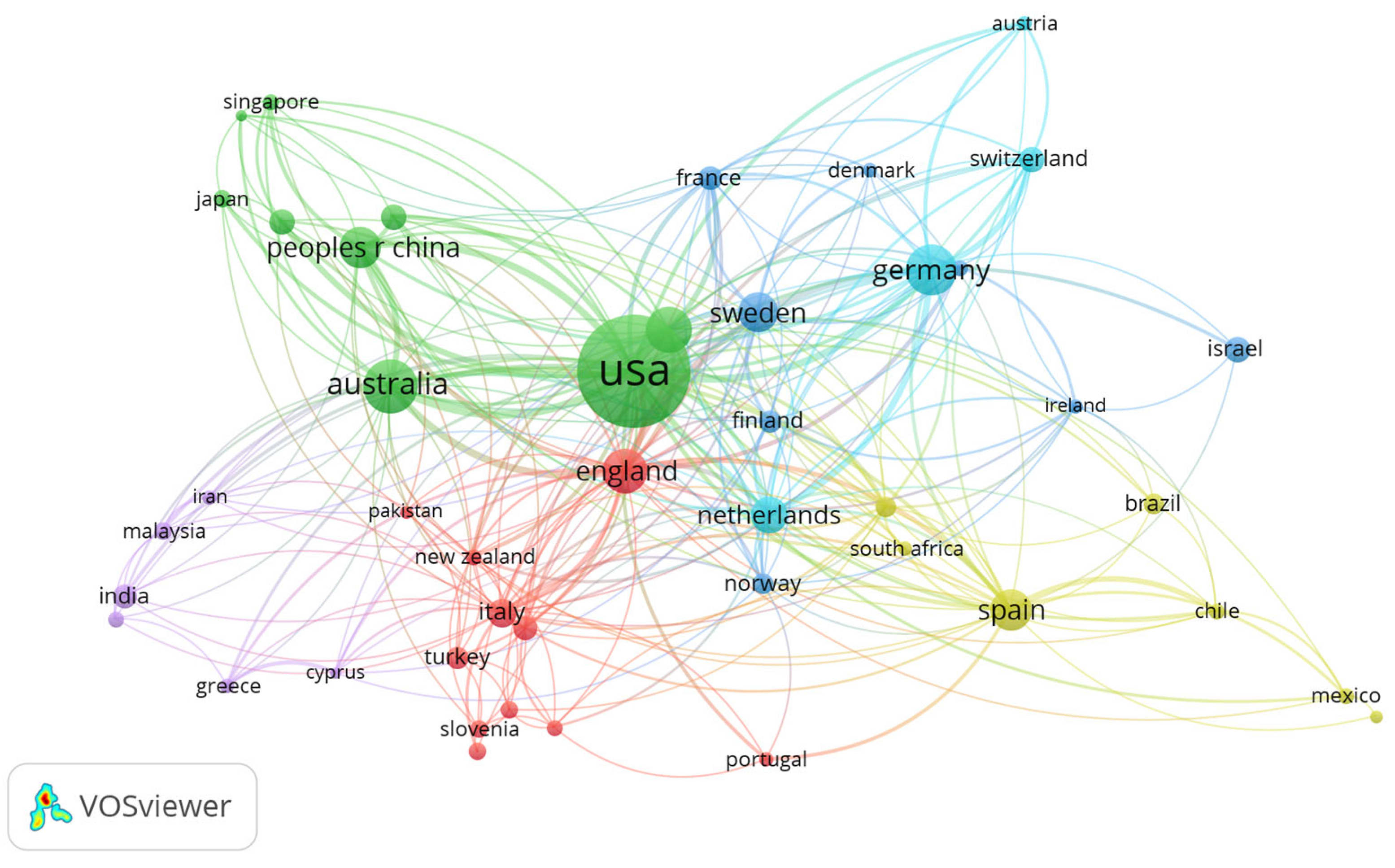
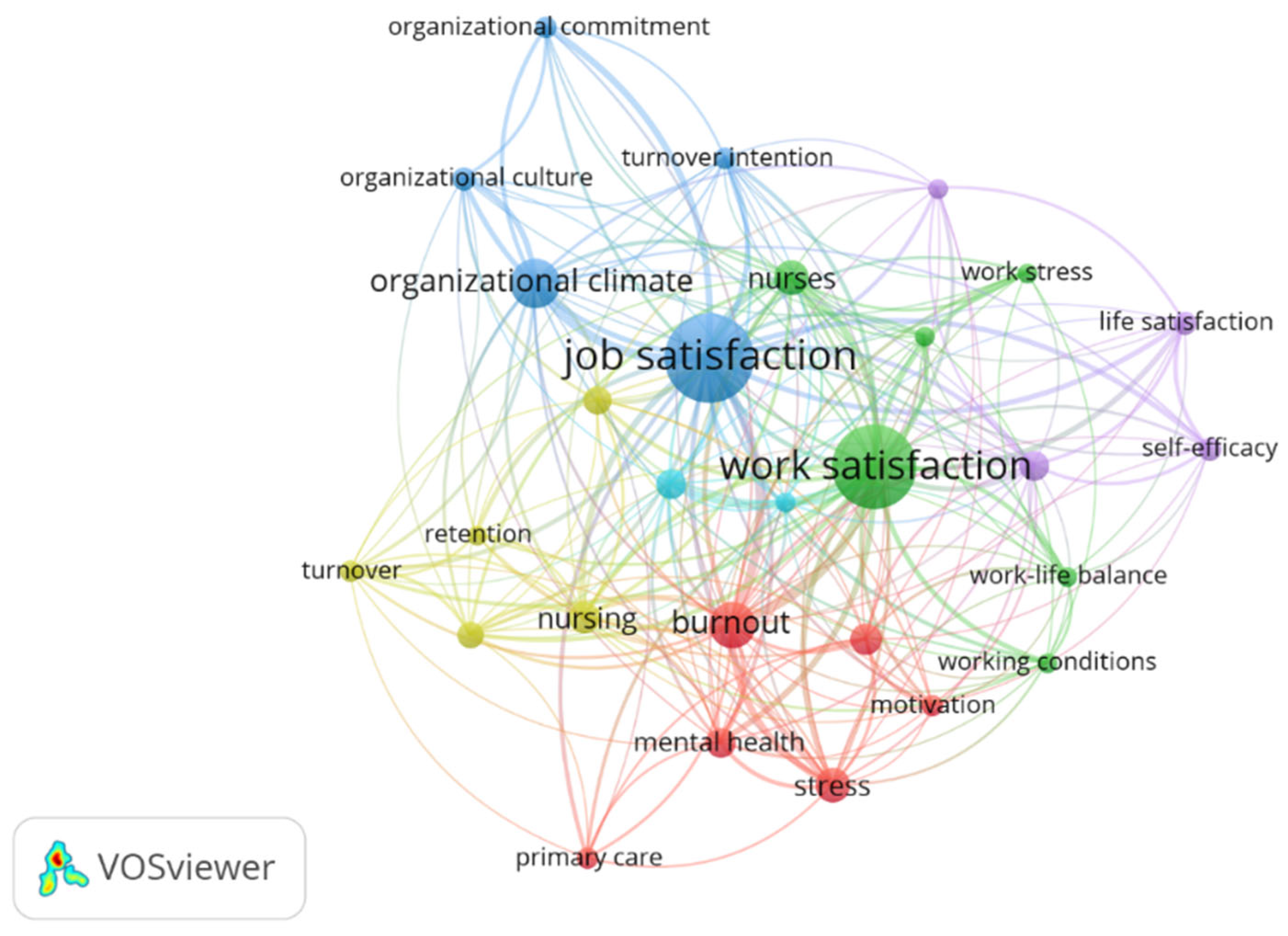
| Number of Citations | Number of Articles | % of Items |
|---|---|---|
| More than 1000 | 1 | 0.04% |
| More than 500 less than 1000 | 9 | 0.40% |
| More than 250 less than 500 | 23 | 1.03% |
| More than 100 less than 250 | 120 | 5.39% |
| More than 50 less than 100 | 193 | 8.66% |
| less than 50 | 1.670 | 74.96% |
| 0 Quotes | 212 | 9.52% |
| Total | 2.228 | 100.00% |
| R | Authors | Year | Title | Magazine | TC |
|---|---|---|---|---|---|
| 1 | Anderson, NR; Oeste, MA | 1998 | Climate Measurement for Innovation in Working Groups: Development and Validation of the Team’s Climate Inventory | Journal of Organizational Behavior | 1.085 |
| 2 | Hoegl, M; Gemuenden, HG (Hoegl & Gemuenden, 2001) | 2001 | Quality of teamwork and success of innovative projects: a theoretical concept and empirical evidence | Organization Science | 852 |
| 3 | Denison, Dominican Republic | 1996 | What is the difference between organizational culture and organizational climate? A native’s view on a decade of paradigm wars | Management Review Academy | 823 |
| 4 | Liden, RC; Wayne, SJ; Sparrow, RT | 2000 | An examination of the mediating role of psychological empowerment in the relationships between work, interpersonal relationships, and work outcomes | Journal of Applied Psychology | 789 |
| 5 | Bloom, Nicolás; Liang, James; Roberts, John; Ying, Zhichun Jenny | 2015 | Does working from home work? Evidence from a Chinese experiment | Quarterly Journal of Economics | 597 |
| 6 | Fitzgerald, LF; Drasgow, F; Hulin, CL; Gelfand, MJ; Magley, VJ | 1997 | Background and consequences of sexual harassment in organizations: a test of an integrated model | Journal of Applied Psychology | 569 |
| 7 | Seibert, SE; Plata, SR; Randolph, WA | 2004 | Taking Empowerment to the Next Level: A Multi-Tiered Model of Empowerment, Performance, and Satisfaction | Journal of the Academy of Management | 563 |
| 8 | Dumont, Jenny; Shen, Jie; Deng, Xin | 2017 | Effects of Green Human Resource Management Practices on Employee Green Behavior in the Workplace: The Role of Psychological Green Climate and Employees’ Green Values | Human Resource Management | 554 |
| 9 | Willness, Chelsea R.; Acero, Muelles; Lee, Kibeom | 2007 | A meta-analysis of the background and consequences of sexual harassment in the workplace | Staff Psychology | 546 |
| 10 | Spreitzer, gerente general; Kizilos, MA; Nason, SW | 1997 | A dimensional analysis of the relationship between psychological empowerment and effectiveness, satisfaction, and tension | Management Journal | 508 |
| R | Author’s Name | Institution | TP-OC | TC-OC | % | AND | TP-A | TC-A | T116 |
|---|---|---|---|---|---|---|---|---|---|
| 1 | Laschinger, Heather | Universidad de Western Ontario | 11 | 2.027 | 2.95% | 63 | 124 | 11.456 | 7 |
| 2 | Shamian, Judith | International Council of Nurses | 6 | 1.390 | 2.02% | 22 | 61 | 4.390 | 5 |
| 3 | Oeste, Michael | Lancaster University | 3 | 1.449 | 2.11% | 48 | 106 | 11.236 | 5 |
| 4 | Anderson, Nicolás | University of Alabama, Birmingham | 1 | 1.085 | 1.58% | 21 | 69 | 3.963 | 1 |
| 5 | Cuaresma, Robert W. | University of Maryland, University Park | 12 | 956 | 1.39% | 61 | 160 | 17.889 | 2 |
| 6 | Finegan, Joan | Western University | 4 | 927 | 1.35% | 19 | 22 | 2.491 | 4 |
| 7 | Aarons, Gregory | University of California San Diego | 9 | 727 | 1.06% | 54 | 202 | 10.668 | 3 |
| 8 | Vallerand, Robert | University of Quebec in Montreal | 5 | 543 | 0.79% | 84 | 267 | 29.165 | 3 |
| 9 | Fouquereau, Evelyne | University of Tours | 6 | 520 | 0.76% | 21 | 56 | 1.565 | 2 |
| 10 | The guild, Nicolás | University of Tours | 6 | 520 | 0.76% | 35 | 142 | 3.615 | 2 |
| R | Author’s Name | University | TP-OC | TC-OC | PC-OC | % Tt | H-A | TP-A | TC-A |
|---|---|---|---|---|---|---|---|---|---|
| 1 | Cuaresma, Robert W. | University of Maryland, University Park | 12 | 956 | 79.67 | 0.54% | 61 | 160 | 17.889 |
| 2 | Burke, Ronald J | York University—Canada | 11 | 299 | 27.18 | 0.49% | 36 | 231 | 4.466 |
| 3 | Laschinger, Heather | Universidad de Western Ontario | 11 | 2.027 | 184.27 | 0.49% | 63 | 124 | 11.456 |
| 4 | Poghosyan, Lusine | Columbia University | 11 | 299 | 27.18 | 0.49% | 26 | 156 | 2.953 |
| 5 | Aarons, Gregory | University of California San Diego | 9 | 727 | 80.78 | 0.40% | 54 | 202 | 10.668 |
| 6 | Shamian, Judith | International Council of Nurses | 6 | 1.390 | 231.67 | 0.27% | 22 | 61 | 4.390 |
| 7 | Büssing A | Technical University of Munich | 6 | 95 | 15.83 | 0.27% | 4 | 4 | 138 |
| 8 | Fouquereau, Evelyne | University of Tours | 6 | 520 | 86.67 | 0.27% | 21 | 56 | 1.565 |
| 9 | The guild, Nicolás | University of Tours | 6 | 520 | 86.67 | 0.27% | 35 | 142 | 3.615 |
| 10 | Hirsch, Oliver | University of Applied Sciences FOM | 6 | 39 | 6.50 | 0.27% | 17 | 60 | 966 |
| Total of the set | 72 | 4.962 | 68.92 | 3.23% | 35 |
| Cluster 1 (5) –Red | Cluster 2 (4) –Green | Cluster 3 (3) –Blue | Cluster 4 (3) Yellow | Cluster 5 (6) Purple |
| Brown, Steven D. | Fouquereau, Evelyne | Adarkwah, Charles (2) | Finegan, j (2) | Burke, RI (1) |
| Duffy, Ryan d. | The guild, Nicolás | Hirsch, Oliver (2) | Laschinger, hks (2) | Greenglass, er (1) |
| Cuaresma, Robert w. (4) | Philippe, Federico I. | Labenz, Joachim (2) | Shamian, j (2) | |
| Sheu, Hung-bin | Vallerand, Robert J. (3) | |||
| Taveira, Maria do Céu | ||||
| Cluster 6 (2) light blue | Cluster 7 (2) –orange | Cluster 8 (2) –grey | Cluster 9 (2) –pink | Cluster 10(1) light pink |
| Boumans, npg (1) | Eason, Christianne m. (1) | Liu, Jian colmillo (1) | Claiborne, Nancy (1) | Aarons, Gregory a. |
| Landeweerd, yo (1) | Mazerolle, Stephanie (1) | Poghosyan, Lusine (1) | Zeitlin, Wendy (1) | |
| Cluster 11 (1) green | Cluster 12 (1) gray | Cluster 13 (1) light green | Cluster 14 (1) light purple | Cluster 15 (1) light blue |
| Cortina, Lilia m. | Grandjean, bd | Hasson, Henna | Karanikola, María n. k. | Kirkcaldy, de |
| Cluster 16 (1) light orange | Cluster 17 (1) light grey | Cluster 18 (1) light pink | Cluster 19 (1) Grey | Cluster 20 (1) light grey |
| Laschinger, heather k. sp | McCaughey, Deirdre | Mottaz, CJ | Rozman, Maja | Motion, Willibald |
| R | Sources (Magazines) | N | % Tt | TC-OC | PC-OC | H-OC | FI 5 Years | Q |
|---|---|---|---|---|---|---|---|---|
| 1 | Journal of Nursing Management | 48 | 2.15% | 2.532 | 52.75 | 25 | 5.2 | Second trimester |
| 2 | International Journal of Environmental Research and Public Health | 39 | 1.75% | 453 | 11.62 | 13 | 4.7 | Second trimester |
| 3 | Journal of Advanced Nursing | 31 | 1.39% | 1.101 | 38.52 | 20 | 3.8 | Question 1 |
| 4 | Frontiers in psychology | 30 | 1.35% | 367 | 12.23 | 9 | 4.3 | Question 1 |
| 5 | Journal of Vocational Behavior | 29 | 1.30% | 1.821 | 62.79 | 20 | 10.5 | Question 1 |
| 6 | Journal of Nursing Administration | 25 | 1.12% | 1.433 | 57.32 | 15 | 2.1 | Second trimester |
| 7 | Journal of Clinical Nursing | 22 | 0.99% | 536 | 24,36 | 13 | 4 | Question 1 |
| 8 | Working a Prevention Journal Evaluation Rehabilitation | 21 | 0.94% | 261 | 12.43 | 10 | 2.3 | Third trimester |
| 9 | Journal of Work and Organizational Psychology | 19 | 0.85% | 116 | 6.11 | 6 | 1 | Question 4 |
| 10 | Sustainability | 18 | 0.81% | 310 | 17.22 | 9 | 4 | Second trimester |
| Total sets | 282 | 12.66% | 9.023 | 32 | 47 |
| R | Organizations | Country | For Example | % Tt | TC-OC | PC-OC | h-OC |
|---|---|---|---|---|---|---|---|
| 1 | Ohio University System | United States | 41 | 1.84% | 2.175 | 53.1 | 21 |
| 2 | University of California System | United States | 40 | 1.80% | 1.525 | 38.1 | 20 |
| 3 | Florida State University System | United States | 37 | 1.66% | 1.511 | 40.8 | 21 |
| 4 | Pennsylvania Commonwealth System of Higher Education | United States | 35 | 1.57% | 1.062 | 30.3 | 17 |
| 5 | University of Wisconsin System | United States | 35 | 1.57% | 1.504 | 43.0 | 19 |
| 6 | Harvard University | United States | 32 | 1.44% | 836 | 26.1 | 13 |
| 7 | University System of Maryland | United States | 26 | 1.17% | 2.642 | 101.6 | 17 |
| 8 | University of North Carolina | United States | 25 | 1.12% | 1.726 | 69.0 | 18 |
| 9 | Instituto Karolinska | Switzerland | 23 | 1.03% | 817 | 35.5 | 15 |
| 10 | State University of New York Suny System | United States | 23 | 1.03% | 990 | 43.0 | 14 |
| Overview of the set | 297 | 14.23% | 13.624 | 45.87 | 59 |
| Group 1 (7 items) | Group 2 (Item 7) | Group 3 (7 items) | Group 4 (5 topics) |
|---|---|---|---|
| Columbia University (3) | Maastricht University | Deakin University | Instituto Karolinska (5) |
| Harvard Medical School (3) | Radboud University Numegen | Monash University | Lund University |
| Harvard University | Tilburg University | University of Queensland Techno | University Deck |
| Stanford University (3) | University of Amsterdam (4) | University of Edinburgh | Uppsala University |
| Suny Albany | University of Groningen | University of Melbourne | Wayne State University |
| University of Maryland | University of Zurich | University of New South Wales | |
| University of Pittsburgh | University of Amsterdam | University of Queensland (7) | |
| Group 5 (5 topics) | Group 6 (4 items) | Group 7 (4 topics) | |
| Universidad Case Western Reserve | Michigan State University | Universidad Northwestern (4) | |
| Katholieke University Leuven | Texas A&M University | University of Massachusetts (4) | |
| Pennsylvania State University (5) | University of Michigan (6) | University of Minnesota | |
| Tel Aviv University | University of North Carolina | University of Wisconsin (4) | |
| University of Valencia |
| R | Countries/Regions | NP | % Tt | TC-OC | PC-OC | h-OC |
|---|---|---|---|---|---|---|
| 1 | United States | 741 | 33.26% | 32.669 | 55.09 | 88 |
| 2 | Australia | 176 | 7.90% | 5.550 | 31.53 | 37 |
| 3 | Germany | 161 | 7.23% | 4.209 | 26.14 | 32 |
| 4 | Canada | 137 | 6.15% | 7.326 | 53.47 | 44 |
| 5 | England | 121 | 5.43% | 6.692 | 55.31 | 40 |
| 6 | R. of China Peoples | 105 | 4.71% | 3.705 | 35.29 | 26 |
| 7 | Spain | 105 | 4.71% | 1.656 | 15.77 | 23 |
| 8 | Sweden | 101 | 4.53% | 2.411 | 23.87 | 29 |
| 9 | Netherlands | 85 | 3.82% | 2.716 | 31.95 | 30 |
| 10 | Israel | 55 | 2.47% | 1.371 | 24.93 | 18 |
| Overview of the set | 1.592 | 71.454% | 58.237 | 36.58 | 108 |
| Cluster 1 (Red-11) | Group 2 (Green-9) | Cluster 3 (Blue-8) | Group 4 (Yellow-7) | Cluster 5 (Purple-6) | Cluster 6 (Light Blue-4) |
|---|---|---|---|---|---|
| England (35) | Australia | Denmark | Belgium | Cyprus (8) | Austria |
| Indonesia | Canada | Finland | Brazil | Greece | Germany |
| Italy | Japan | France | Chile | India (8) | Netherlands (23) |
| New Zealand | R. China Peoples | Ireland | Colombia | Iran | Switzerland |
| Pakistan | Singapore | Israel | Mexico | Malaysia (8) | |
| Poland | South Korea | Norway | South Africa | Saudi Arabia | |
| Portugal | Taiwan | Scotland | Spain (26) | ||
| Romania | United States (35) | Sweden (19) | |||
| Russia | Vietnam | ||||
| Slovenia | |||||
| Türkiye |
| Cluster 1 6 items—red | Burnout—mental health—motivation—primary care—satisfaction—stress |
| Cluster 2 6 items—green | Nurses—quality of life—job satisfaction—work stress—work–life balance—working conditions |
| Cluster 3 5 items—blue | Job satisfaction—Organizational climate—Organizational commitment—Organizational culture—Turnover intention |
| Cluster 4 5 items—yellow | Leadership—Nursing—Retention—Turnover—Work Environment |
| Group 5 4 items—purple | Life Satisfaction—Self-Efficacy—Well-Being—Work-Family Conflict |
| Group 6 2 items—light blue | COVID-19—Work Engagement |
| N | Keyword | Occurrence |
|---|---|---|
| 1 | Job satisfaction | 359 |
| 2 | Work satisfaction | 324 |
| 3 | Organizational climate | 121 |
| 4 | Burnout | 110 |
| 5 | Stress | 60 |
| 6 | Nurses | 60 |
| 7 | nursing | 54 |
| 8 | satisfaction | 52 |
| 9 | Welfare | 49 |
| 10 | mental health | 48 |
Disclaimer/Publisher’s Note: The statements, opinions and data contained in all publications are solely those of the individual author(s) and contributor(s) and not of MDPI and/or the editor(s). MDPI and/or the editor(s) disclaim responsibility for any injury to people or property resulting from any ideas, methods, instructions or products referred to in the content. |
© 2025 by the authors. Licensee MDPI, Basel, Switzerland. This article is an open access article distributed under the terms and conditions of the Creative Commons Attribution (CC BY) license (https://creativecommons.org/licenses/by/4.0/).
Share and Cite
Rubio, R.; Araya-Castillo, L.; Moraga-Flores, H.; Ortega Frei, M.F. Trends, Collaborations and Perspectives in the Study of Organizational Climate and Job Satisfaction: A Bibliometric and Scientometric Analysis. Adm. Sci. 2025, 15, 389. https://doi.org/10.3390/admsci15100389
Rubio R, Araya-Castillo L, Moraga-Flores H, Ortega Frei MF. Trends, Collaborations and Perspectives in the Study of Organizational Climate and Job Satisfaction: A Bibliometric and Scientometric Analysis. Administrative Sciences. 2025; 15(10):389. https://doi.org/10.3390/admsci15100389
Chicago/Turabian StyleRubio, Ramón, Luis Araya-Castillo, Hugo Moraga-Flores, and María Francisca Ortega Frei. 2025. "Trends, Collaborations and Perspectives in the Study of Organizational Climate and Job Satisfaction: A Bibliometric and Scientometric Analysis" Administrative Sciences 15, no. 10: 389. https://doi.org/10.3390/admsci15100389
APA StyleRubio, R., Araya-Castillo, L., Moraga-Flores, H., & Ortega Frei, M. F. (2025). Trends, Collaborations and Perspectives in the Study of Organizational Climate and Job Satisfaction: A Bibliometric and Scientometric Analysis. Administrative Sciences, 15(10), 389. https://doi.org/10.3390/admsci15100389





